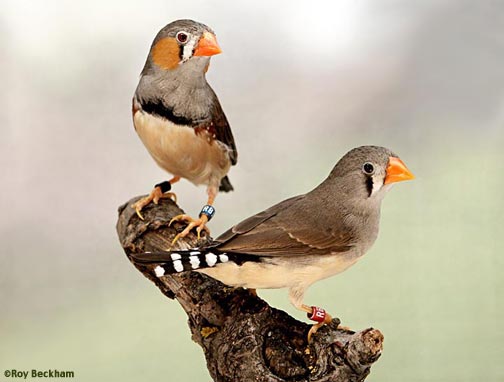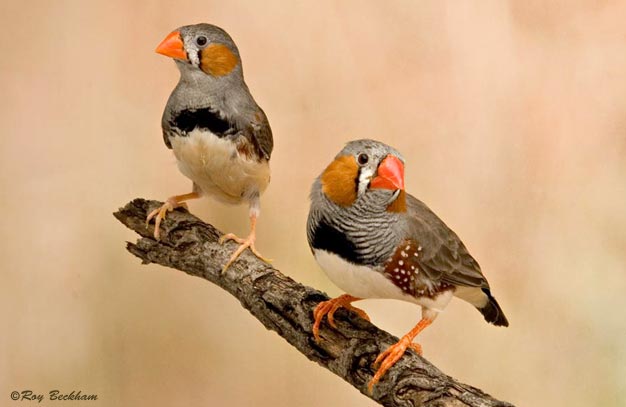




 |
|
|||||||||||||||||||||
 |
|
|
|
|
|
|
|
|
|
|||||||||||||
|
|
|
|
|
|
||||||||||||||||||
|
|
|
|
|
|
|
|
|
|
||||||||||||||
|
|
|
|
|
|
||||||||||||||||||
|
|
|
|
|
|
|
|
|
|
||||||||||||||
|
|
|
|
|
|
||||||||||||||||||
|
|
|
|
|
|
|
 |
|
|||||||||||||||
 |
 |
|
||||||||||||||||||||
|
|
|
|
||||||||||||||||||||
|
|
|
|
|
|
|
|
|
|
|
|
|
|
|
|
|
|
|
|
|
|
|
|
| Timor Zebra Finch - Taeniopygia guttata guttata | |||||
 |
|||||
| Timor Zebra Finches (male left, female right) | |||||
|
Common Names Description
Male: Timor Zebra males have a smaller breast bar and the throat stripes are nearly gone compared to Australian Zebras (T. guttata castanotis). Between the beak and throat, the stripes are completely missing. The voice of the Timor is also much higher and the song is more rapid than the Australian Zebra. They are also generally smaller than their Australian cousins, but since the Australian Zebra is so variable in size due to selective breeding for the show bench, it is difficult to use this as a form of comparison. Some Australian Zebras are as small as a Timor Zebra. The Timor is approximately 10.5 grams. Female: Nearly indistinguishable from gray Australian Zebra Finch. Only the voice of the Timor Zebra finch can be used to determine Timor hens from Australian hens. A Timor Zebra male (click to view) See my Australian x Timor Hybrid Results Diet Breeder's Notes They will breed readily in cages or aviaries, as individual pairs and in a colony. My preference is to breed them in colonies whether in cages or in aviaries. It is interesting to see the interaction of the birds in this situation. I started breeding them in my standard 3' flight cage and would use bamboo to offer them some cover. I placed 3 pairs together in this setting with very good results. I also had very good results with a larger colony in an outside aviary. They are peaceful little birds that should be fine in most mixed colonies. I have them in a large flight with a few White-rumped mannikins with no problems with either bird. The only problem might be that the White-rumps are far outnumbered by the Timors and have not made any serious attempts at breeding thus far. Timors are very hyperactive birds. With their small size and active nature, they are like Owl finches in Zebra finch clothing. While I treat them very much like my Australian Zebras, the Timors cannot be considered as "indestructible". They are a bit more fragile and the aviculturist may do better to treat them like he would a small waxbill rather than just another Zebra finch. This is not to say that they are not hardy birds, only when compared to the Australian Zebra can they be considered more fragile. They do not seem to be able to take the lower temperatures that the Aus. Zebra can and may be more susceptible to disease. Overcrowding of the Timors will also bring diminishing returns as the young are abandoned more readily. Additional Notes The Timor should not be housed with the Australian zebra while breeding. They will readily hybridize and you will lose the unique characteristics of the Timor Zebra finch which is really the charm of the bird. I do not house the two together at any point. Young males that are housed with Australian Zebras may also lose some of the unique characteristics of their song. The Timor's song is more rapid and has more notes than the Australian. The late Dr. Luis Baptista referred to the those that were fostered as having a "lazy" song since it was not as complex as the original Timor song. (See my hybrid experiments with the Australian and Timor Zebra. I do not recommend others hybridize their birds. This was done for a very specific purpose and I will not be repeating it in the future) In an effort to help keep the Timors from being lost, I have started to use a band on all those I sell that identifies them as Timor Zebra finches. I recommend others do the same (see the bands) There are no known mutations of the Timor Zebra. I would be very hesitant to accept any new mutation as being developed exclusively from Timor lines. More likely, any mutations that are seen in the near future are more likely the result of introduction of established mutations in the Australian Zebra finch. The Timor Zebra finch can still be imported from its native habitat of the Lesser Sundas islands and Indonesia, yet there has never been a high demand for this particular species of Zebra and is considered rare in Aviculture. It has been rumored that they did exist in some aviaries in the US sometime in the 1970's, but later died out or were mixed with regular Australian Zebras and lost that way. A few aviculturists, myself included, are working to establish this unique species in the US. A stamp showing both the Australian and Timor Zebra finch from the African Republic of Guinea. (Click to view stamp) |

Timor male,(left) Australian male, (right). Notice the lack of stripes under the beak of the Timor.
